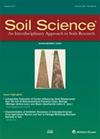The application of biochar and oyster shell reduced cadmium uptake by crops and modified soil fertility and enzyme activities in contaminated soil
4区 农林科学
Q2 Agricultural and Biological Sciences
引用次数: 4
Abstract
Abstract. Soil pollution with cadmium (Cd) has been threatening the human health. In this study, we investigated the possibility of applying biochar and oyster shell to reduce Cd uptake by crops and modify soil quality. A field study based on the rice–oilseed rape rotation was done, and the treatments were comprised without amendments (PA0) and with 15 000 kg ha−1 biochar (PA1), 15 000 kg ha−1 oyster shell (PA2), and 7500 kg ha−1 biochar and 7500 kg ha−1 oyster shell (PA3). Results revealed that both oyster shell and biochar reduced the HOAc-extractable Cd in soil. Compared to PA0, the HOAc-extractable Cd in the PA1, PA2, and PA3 treatments was reduced by 4.76 %–20.79 %, 17.86 %–38.61 %, and 5.95 %–10.89 %, respectively. The cooperative application of biochar and oyster shell reduced the Cd accumulation in brown rice and oilseed by 29.67 % and 19.74 %, respectively, compared to control and thus decreased the hazard quotient (HQ) from the consumption of brown rice and oilseed. The addition of biochar slightly increased soil organic matter. In addition, the available P in the PA2 and PA3 treatments was significantly (p<0.05) increased by 200.96 %–295.92 % and 187.46 %–280.04 % compared to the control. Moreover, the cooperative application of biochar and oyster shell enhanced the activities of urease, catalase, and β-galactosidase by 139.44 %–147.56 %, 10.71 %–34.31 %, and 82.08 %–244.38 %, respectively. These results demonstrated that the utilization of biochar and oyster shell might be an effective pathway to reducing Cd uptake by crops and improving soil fertility and enzyme activities.生物炭和牡蛎壳的施用降低了作物对镉的吸收,改善了土壤肥力和土壤酶活性
摘要土壤镉污染已严重威胁着人类的健康。在本研究中,我们探讨了施用生物炭和牡蛎壳降低作物对Cd的吸收和改善土壤质量的可能性。在水稻-油菜轮作的基础上进行了田间试验,处理包括不加改性剂(PA0)、15 000 kg ha - 1生物炭(PA1)、15 000 kg ha - 1牡蛎壳(PA2)、7500 kg ha - 1生物炭和7500 kg ha - 1牡蛎壳(PA3)。结果表明,牡蛎壳和生物炭均能降低土壤中hoac可提取Cd的含量。与PA0处理相比,PA1、PA2和PA3处理的hoac可萃取Cd分别降低4.76% ~ 20.79%、17.86% ~ 38.61%和5.95% ~ 10.89%。与对照相比,生物炭与牡蛎壳配合施用使糙米和油籽Cd累积量分别降低了29.67%和19.74%,从而降低了糙米和油籽消耗的危害系数(HQ)。生物炭的添加使土壤有机质略有增加。此外,PA2和PA3处理的有效磷含量较对照显著(P <0.05)提高了200.96% ~ 295.92%和187.46% ~ 280.04%。此外,生物炭与牡蛎壳配合施用,脲酶、过氧化氢酶和β-半乳糖苷酶的活性分别提高了139.44% ~ 147.56%、10.71% ~ 34.31%和82.08% ~ 244.38%。这些结果表明,生物炭和牡蛎壳的利用可能是减少作物对Cd的吸收,提高土壤肥力和酶活性的有效途径。
本文章由计算机程序翻译,如有差异,请以英文原文为准。
求助全文
约1分钟内获得全文
求助全文
来源期刊

Soil Science
农林科学-土壤科学
CiteScore
2.70
自引率
0.00%
发文量
0
审稿时长
4.4 months
期刊介绍:
Cessation.Soil Science satisfies the professional needs of all scientists and laboratory personnel involved in soil and plant research by publishing primary research reports and critical reviews of basic and applied soil science, especially as it relates to soil and plant studies and general environmental soil science.
Each month, Soil Science presents authoritative research articles from an impressive array of discipline: soil chemistry and biochemistry, physics, fertility and nutrition, soil genesis and morphology, soil microbiology and mineralogy. Of immediate relevance to soil scientists-both industrial and academic-this unique publication also has long-range value for agronomists and environmental scientists.
 求助内容:
求助内容: 应助结果提醒方式:
应助结果提醒方式:


